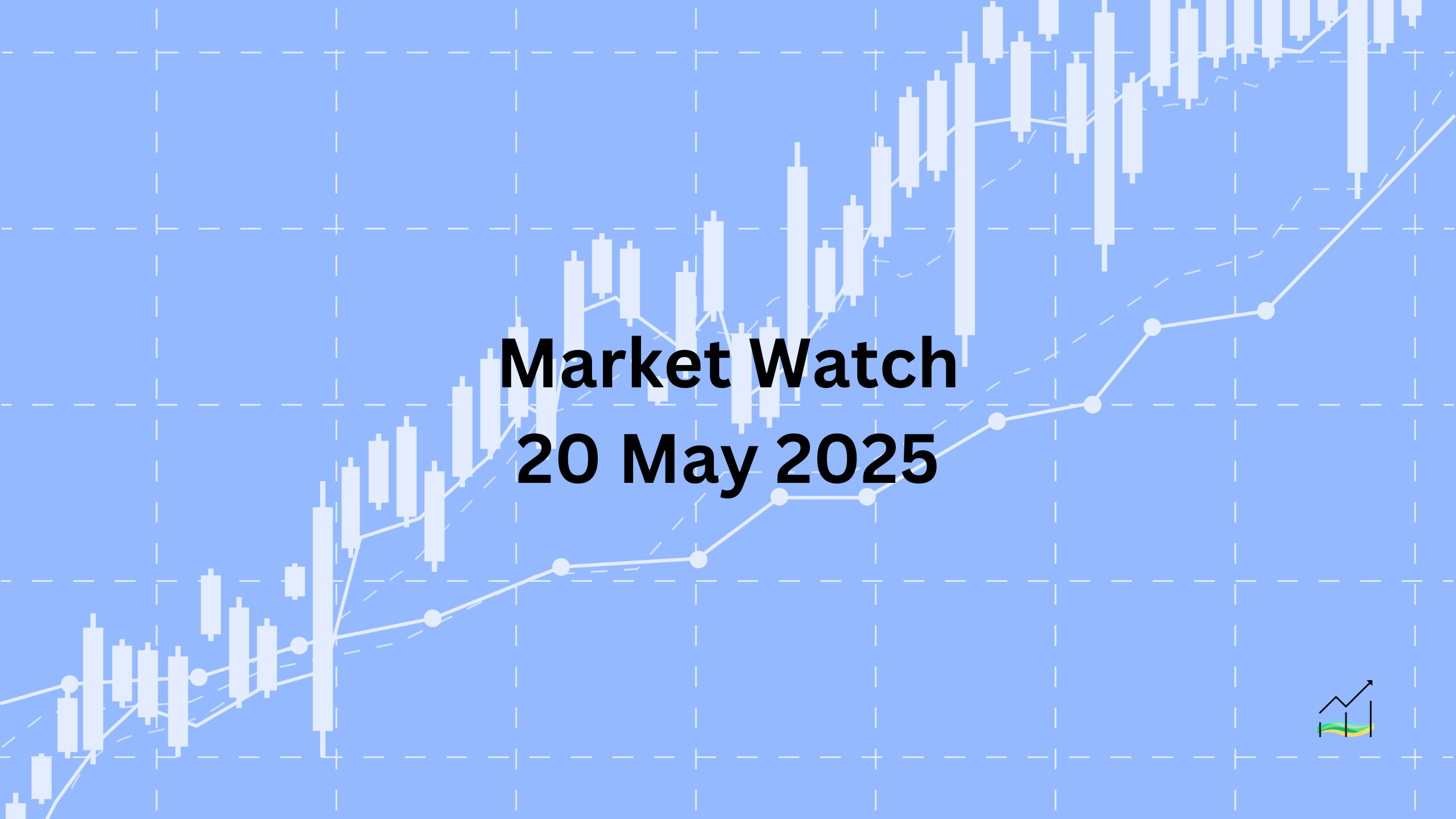20/05/2025 Market Watch

Markets Stabilise but Dollar Stays Under Pressure
Key Takeaways:
- US stocks and bonds rebounded after recent declines in Asia and Europe.
- The Swiss National Bank reaffirmed the global reliance on US Treasuries.
- The dollar remained under pressure in global markets.
- Antipodean currencies weakened following Australia’s dovish rate decision.
- Major equity indices in Asia and Europe posted gains.
- Gold held steady above $3200; oil remained flat near $62.
US equities and Treasuries regained ground after the previous session’s losses, reflecting improved sentiment across Asia and Europe. In a statement that resonated with global investors, Swiss National Bank President Schlegel noted that there is currently no viable alternative to US Treasuries, reinforcing the asset class’s dominant position. Treasury yields eased, with the 10-year and 30-year notes falling 3–4 basis points, while equity markets closed higher.
Despite the recovery in risk sentiment, the dollar continued to face pressure in both the Asia Pacific and European sessions. Among the G10 currencies, only the Australian and New Zealand dollars weakened, largely due to the Reserve Bank of Australia's dovish policy tone following a rate cut. Emerging market currencies showed mixed performance, lacking a clear directional bias.
Asian equity markets followed Wall Street’s lead, with most major indices posting gains. The Stoxx 600 in Europe extended its advance and is on track for a fourth consecutive daily gain, with only three down days so far this month. However, US index futures were mildly lower ahead of the open. In bond markets, Japan’s long-term yields inched higher after a weak 20-year auction, while Australian yields dropped sharply following the central bank decision. European yields were slightly lower, and US 10-year yields hovered near 4.45%.
Commodity markets remained relatively calm. Gold held firm above $3200, though it stayed below yesterday’s high. Crude oil prices were flat, with July WTI trading near the $62 level.
United States of America
Overview
The Dollar Index remained volatile, setting a session low just above 100.00 before climbing steadily through the North American session to reach 100.50. However, fresh selling pressure in early European trade pushed the index back down, briefly breaching yesterday’s low while still holding above the 100.00 threshold. Momentum indicators appear stretched, reflecting the recent bottom established a month ago.
This week’s economic calendar does not include major US data releases that could significantly shift market sentiment. Notably, US markets seemed largely indifferent to Moody’s recent downgrade — the final of the three major agencies to do so — in contrast to the stronger reactions seen in Asia and Europe. Treasury Secretary Bessent has hinted at the possibility of reintroducing reciprocal tariffs similar to those applied in April, presenting them as part of a broader strategy, though critics suggest the approach lacks coherence.
On the geopolitical front, Beijing criticised Washington’s renewed efforts to curb the use of Huawei AI chips, calling the move provocative and counterproductive to ongoing trade negotiations. China also hinted at potential retaliation without providing specific details. Meanwhile, the market continues to digest the outlook for monetary policy. Fed officials remain active in public commentary, with at least six scheduled to speak today. Last week’s repricing of interest rate expectations has pushed the likelihood of a rate cut from Q3 into Q4, with some now doubting whether two cuts will materialise at all this year. Atlanta Fed President Bostic, for example, indicated he currently expects just one cut in 2025.
Economic Drivers
- US markets largely shrugged off Moody’s downgrade, while international markets reacted more sharply.
- Treasury Secretary Bessent signalled possible renewed tariffs, though his framing of "strategic uncertainty" was seen by many as unclear.
- China denounced new US efforts against Huawei as provocative and potentially harmful to trade negotiations.
- Market expectations for Fed rate cuts have been pushed back to Q4, with reduced confidence in the likelihood of two cuts this year.
Data and Events
No major economic releases are scheduled today.
Price Action
- The Dollar Index bounced from a low near 100.00 to 100.50 before retracing.
- Momentum indicators appear stretched following last month’s bottom.
- Derivatives pricing shows hesitation, with futures re-evaluating the probability of multiple Fed rate cuts this year.
Key Points:
- Dollar Index remains range-bound with resistance near 100.50.
- US market sentiment appears resilient to Moody’s downgrade.
- Beijing's warning over Huawei tensions increases geopolitical uncertainty.
- Market consensus on Fed policy is shifting toward fewer rate cuts in 2025.
- High-frequency Fed commentary may continue to influence short-term sentiment.
Australia
Overview
The Australian dollar found demand ahead of the Reserve Bank of Australia's latest rate decision, where the central bank followed through with a widely anticipated 25 basis point cut. This brought the official cash rate down to 3.85%. The policy stance was notably dovish, with Governor Bullock disclosing that policymakers had weighed the option of a more aggressive 50 basis point cut during deliberations.
In line with this softer tone, the RBA revised down both its economic growth and inflation forecasts. The central bank now expects GDP growth in 2025 to reach just 2.1%, down from 2.4%, while inflation is projected to slow to 3.0% compared to the previous estimate of 3.7%. Market expectations quickly adjusted in response, with the implied year-end rate target dropping from 3.34% to 3.16%. The new projections also left room for up to 65 basis points of easing in the second quarter of 2026, adding further weight to the dovish outlook.
Economic Drivers
- RBA cut its cash rate by 25 basis points to 3.85%.
- Governor Bullock revealed the board debated a larger 50 bp cut, indicating strong dovish sentiment.
- Economic growth forecast for 2025 downgraded from 2.4% to 2.1%.
- Inflation forecast reduced from 3.7% to 3.0%, signalling slower price pressures ahead.
- Market-implied policy rate for year-end lowered from 3.34% to 3.16%.
- RBA projections allow for an additional 65 basis points of easing in Q2 2026.
Data and Events
- 20 May 2025: Cash Rate.
- 20 May 2025: RBA Monetary Policy & Rate Statement.
- 20 May 2025: RBA Press Conference.
Price Action
- The Australian dollar climbed before the rate cut, briefly holding below $0.6465.
- Following the announcement, the currency declined toward $0.6410.
- It has since remained below $0.6430 in a consolidation phase.
Key Points:
- RBA delivered a dovish 25 bp rate cut to 3.85%.
- Growth and inflation forecasts were both lowered.
- Market adjusted year-end rate expectations downward.
- The Australian dollar weakened after the announcement and is consolidating near recent lows.
Canada
Overview
The Canadian dollar traded within a narrow band, as the greenback softened to a three-day low near CAD1.3920 before rebounding to around CAD1.3965. Despite the movement, the pair continues to hold within the broader consolidation range established last Monday between CAD1.3895 and CAD1.4015. So far today, price action has remained within a narrower band of approximately CAD1.3930 to CAD1.3970, suggesting a lack of directional conviction ahead of key inflation data.
Canada's April consumer price index is in focus, with the consensus pointing to a 0.2% month-over-month decline. If confirmed, this would mark the first monthly decline of 2025 and a shift from earlier price gains. Notably, there were four months in 2024 where the CPI recorded monthly declines, followed by a rebound largely driven by the end of the VAT holiday. Despite the anticipated pullback, inflation in the first four months of this year would still be running at an annualised pace of 3.9%. Core inflation is expected to remain steady, slightly below 3%, reflecting relatively stable underlying price trends.
Economic Drivers
- The Canadian dollar traded in a tight range as the market awaits inflation data.
- April CPI is forecast to decline by 0.2%, which would be the first monthly decrease of 2025.
- VAT-related distortions have been the main factor behind recent CPI fluctuations.
- Annualised inflation for the first four months is still projected at 3.9%.
- Core inflation is expected to remain stable just under 3%.
Data and Events
- 20 May 2025: CPI.
Price Action
- USD/CAD dipped to a three-day low near CAD1.3920 before recovering to CAD1.3965.
- Consolidation continues within the broader CAD1.3895 to CAD1.4015 range.
- Intraday movements have been limited to CAD1.3930–CAD1.3970.
Key Points:
- The Canadian dollar is trading sideways ahead of CPI data.
- Inflation is expected to decline slightly in April.
- Core price pressures remain stable just below 3%.
- Market remains confined within a well-defined trading range.
China
Overview
The US dollar strengthened against the offshore yuan, reaching a six-day high near CNH7.2265 after having bottomed last week around CNH7.1790. This upward move brings attention to the CNH7.2350–7.2380 area as the next key chart zone. The People's Bank of China set the daily reference rate for the dollar at CNH7.1931, marking the first upward adjustment in three sessions and only the fourth such move this month, reflecting a subtle shift in currency management.
Recent developments suggest rising demand for yuan among Chinese exporters and investors. Onshore banks recorded a decline in foreign currency deposits in April, reversing a three-year high in March. This signals renewed confidence in the local currency or a strategic reallocation toward yuan-denominated assets. Additionally, Chinese banks aligned with the PBOC’s recent policy easing, cutting key loan prime rates to 3.0% for one-year terms and 3.5% for five-year terms. These adjustments follow a 10 basis point cut to the policy repo rate. With April's economic data underwhelming, pressure is mounting on authorities to ramp up efforts to stimulate domestic demand.
Economic Drivers
- Demand for yuan has increased among exporters and domestic investors.
- Onshore banks reported a decline in foreign currency deposits after reaching a three-year high in March.
- Chinese banks mirrored the PBOC’s 10 basis point cut in the key repo rate.
- Loan prime rates were lowered to 3.0% (one-year) and 3.5% (five-year).
- Softer April data has intensified calls for stronger demand-side stimulus.
Data and Events
No major economic releases are scheduled today.
Price Action
- USD/CNH rose to a six-day high near CNH7.2265.
- The previous low was around CNH7.1790 last week.
- Key technical resistance now lies in the CNH7.2350–7.2380 region.
Key Points:
- USD/CNH strengthened to a six-day high, approaching key resistance levels.
- PBOC signalled policy flexibility with a higher reference rate.
- Domestic demand for yuan appears to be rising.
- Recent rate cuts reflect growing pressure to stimulate economic growth.
Europe
Overview
The euro initially climbed to a peak near $1.1290 during early North American trading but later declined to around $1.1225 in the afternoon session, holding slightly above last Friday’s high near $1.1220. Despite briefly breaking above a four-week descending trendline around $1.1260, it closed the day below it. Today, the euro remains capped below $1.1280, consolidating in the upper range of yesterday’s move and continuing to trade under its 20-day moving average, which it has not closed above in over two weeks.
From a macro perspective, the eurozone posted a notable current account surplus of nearly 51 billion euros in March, pushing the Q1 total to approximately 131.76 billion euros, up from 109 billion euros a year ago. However, this surplus is being largely overlooked by markets, as focus shifts to forward-looking indicators. The European Commission recently lowered its eurozone growth forecast for 2025 to 0.9%, down from 1.3% projected in November. Next year’s estimate was also reduced to 1.4% from 1.6%. These revisions are still more optimistic than both Bloomberg's median forecasts and the IMF’s latest projections, which point to slower growth and a subdued inflation path. Updated ECB staff forecasts are expected next month.
Economic Drivers
- Eurozone current account surplus rose to nearly 51 billion euros in March.
- Q1 current account balance reached 131.76 billion euros, compared to 109 billion euros in Q1 2024.
- European Commission cut its 2025 GDP forecast to 0.9% from 1.3%, and 2026 to 1.4% from 1.6%.
- Bloomberg consensus forecasts GDP at 0.8% (2025) and 1.1% (2026).
- IMF projects GDP at 0.8% this year and 1.2% next year.
- CPI expected to decline to 2.1% in 2025 and 1.7% in 2026.
- IMF sees inflation at 2.1% this year and 1.9% next year.
- ECB staff forecasts will be updated next month.
Data and Events
No major economic releases are scheduled today.
Price Action
- Euro peaked near $1.1290 before retreating to $1.1225.
- Briefly breached four-week downtrend near $1.1260 but settled below it.
- Continues to consolidate below $1.1280 and its 20-day moving average.
Key Points:
- Eurozone current account posted strong Q1 surplus but failed to impact markets.
- Growth and inflation projections were revised lower by the European Commission.
- The euro remains in consolidation, unable to reclaim its 20-day average.
- Market focus remains on forward guidance and upcoming ECB projections.
Japan
Overview
The Japanese yen strengthened, driving the dollar down to an eight-day low just above JPY144.00. This move brings the exchange rate near its 20-day moving average, currently around JPY144.50, a level the dollar has not closed below in the past two weeks. The JPY144.25 region also represents the midpoint retracement of the dollar’s rally from the eight-month low near JPY140 recorded in April. The pair is facing resistance around JPY144.50 in the European session.
Domestic bond markets faced renewed pressure following a poorly received 20-year Japanese Government Bond auction. Yields on 30- and 40-year bonds surged by roughly 12 basis points, reaching record highs. This volatility comes as the Bank of Japan begins surveying market participants on how rapidly it should scale back its government bond purchases.
Japan’s April trade figures are due next, with expectations pointing to a narrower surplus in line with seasonal trends. The country posted an average monthly trade deficit of JPY532 billion in Q1 2025, an improvement compared to the JPY620 billion monthly shortfall in Q1 2024. Meanwhile, despite a contraction in Q1 GDP, Prime Minister Ishiba has dismissed calls for tax cuts and additional fiscal spending. Rising debt servicing costs, now consuming roughly one-quarter of Japan’s national budget, remain a key concern, especially when compared to the US where debt servicing accounts for about 17%.
Economic Drivers
- Weak demand at the 20-year JGB auction triggered a sell-off in long-dated bonds.
- Yields on 30- and 40-year JGBs surged to record highs.
- The Bank of Japan is conducting market surveys on reducing bond purchases.
- April trade surplus is expected to shrink, consistent with seasonal norms.
- Japan’s average monthly trade deficit in Q1 2025 was smaller than in Q1 2024.
- Prime Minister Ishiba ruled out tax cuts and new fiscal stimulus despite GDP contraction.
- Government borrowing costs are rising, with debt service now taking up 25% of the annual budget.
Data and Events
No major economic releases are scheduled today.
Price Action
- USD/JPY fell to an eight-day low slightly above JPY144.00.
- The 20-day moving average near JPY144.50 remains a resistance level.
- JPY144.25 aligns with the 50% retracement from the April low near JPY140.
- Resistance is seen near JPY144.50 during the European session.
Key Points:
- Yen strengthened as bond yields surged after a weak 20-year auction.
- BOJ is assessing market feedback on tapering bond purchases.
- Japan’s fiscal position is under pressure from rising debt service costs.
- April trade data will offer further insight into external balances.
United Kingdom
Overview
Sterling briefly touched a new monthly high yesterday, albeit by only a small margin, before encountering resistance above $1.3400. Sellers stepped in during the North American session, pushing the pound down to around $1.3345. Despite the pullback, the currency registered an outside up day, trading above and below Friday’s range but closing higher. Today, it remains confined to a tight range below $1.3400.
Markets are digesting comments from Bank of England Chief Economist Huw Pill, who warned that interest rates might be coming down too quickly. He advocated a more cautious stance and had dissented at the last policy meeting, which resulted in a rate cut. Meanwhile, inflationary pressures are expected to pick up in April due to a rise in energy and water bills. The headline CPI is forecast to increase by around 1% month-on-month, pushing the annual rate up to 3.3% from 2.6% in March. Core inflation may also rise slightly to 3.6%.
Market pricing reflects these developments, with interest rate futures showing almost no chance of a cut at the June meeting. The probability of an August cut stands at around 75%. The year-end policy rate is now projected at approximately 3.75%, compared to the current target of 4.25% — aligning with the upper end of expectations since early April.
Economic Drivers
- Bank of England Chief Economist Pill warned against cutting rates too quickly, advocating caution.
- Pill dissented at the last policy meeting where the central bank cut rates.
- April energy and water bill increases are expected to push monthly CPI up by 1%.
- Annual inflation is forecast to rise to 3.3% in April from 2.6% in March.
- Core inflation is projected to rise slightly to 3.6%.
- Market expectations show little chance of a June rate cut and around 75% odds for August.
Data and Events
No major economic releases are scheduled today.
Price Action
- Sterling briefly rose above $1.3400 before falling to $1.3345.
- Registered an outside up day with a close above last Friday’s high.
- Currently consolidating in a narrow range below $1.3400.
Key Points:
- Sterling hit a new monthly high but faced immediate selling pressure.
- April inflation is expected to rebound due to utility price increases.
- The BoE is signalling caution on further rate cuts.
- Markets see a high probability of easing in August, but not in June.
© 2025 SKONE Enterprise (003319453-V). All rights reserved.
The content on this site is for informational purposes only and does not constitute financial advice.


